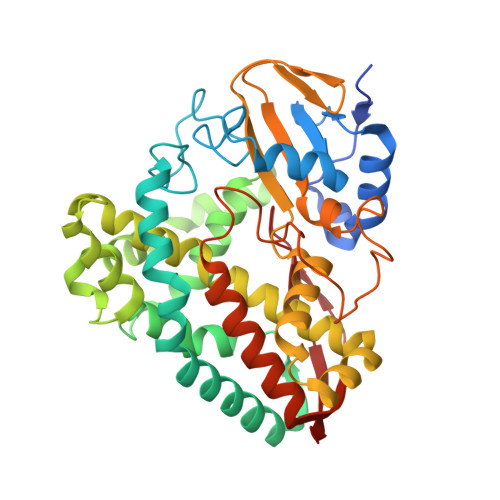The Oxidation of Oxygen and Sulfur-Containing Heterocycles by Cytochrome P450 Enzymes.
Podgorski, M.N., Keto, A.B., Coleman, T., Bruning, J.B., De Voss, J.J., Krenske, E.H., Bell, S.G.(2023) Chemistry 29: e202301371-e202301371
- PubMed: 37338048
- DOI: https://doi.org/10.1002/chem.202301371
- Primary Citation of Related Structures:
7TRT, 7TRU - PubMed Abstract:
The cytochrome P450 (CYP) superfamily of monooxygenase enzymes play important roles in the metabolism of molecules which contain heterocyclic, aromatic functional groups. Here we study how oxygen- and sulfur-containing heterocyclic groups interact with and are oxidized using the bacterial enzyme CYP199A4. This enzyme oxidized both 4-(thiophen-2-yl)benzoic acid and 4-(thiophen-3-yl)benzoic acid almost exclusively via sulfoxidation. The thiophene oxides produced were activated towards Diels-Alder dimerization after sulfoxidation, forming dimeric metabolites. Despite X-ray crystal structures demonstrating that the aromatic carbon atoms of the thiophene ring were located closer to the heme than the sulfur, sulfoxidation was still favoured with 4-(thiophen-3-yl)benzoic acid. These results highlight a preference of this cytochrome P450 enzyme for sulfoxidation over aromatic hydroxylation. Calculations predict a strong preference for homodimerization of the enantiomers of the thiophene oxides and the formation of a single major product, in broad agreement with the experimental data. 4-(Furan-2-yl)benzoic acid was oxidized to 4-(4'-hydroxybutanoyl)benzoic acid using a whole-cell system. This reaction proceeded via a γ-keto-α,β-unsaturated aldehyde species which could be trapped in vitro using semicarbazide to generate a pyridazine species. The combination of the enzyme structures, the biochemical data and theoretical calculations provides detailed insight into the formation of the metabolites formed from these heterocyclic compounds.
- Department of Chemistry, University of Adelaide, Adelaide, SA, 5005, Australia.
Organizational Affiliation:




















